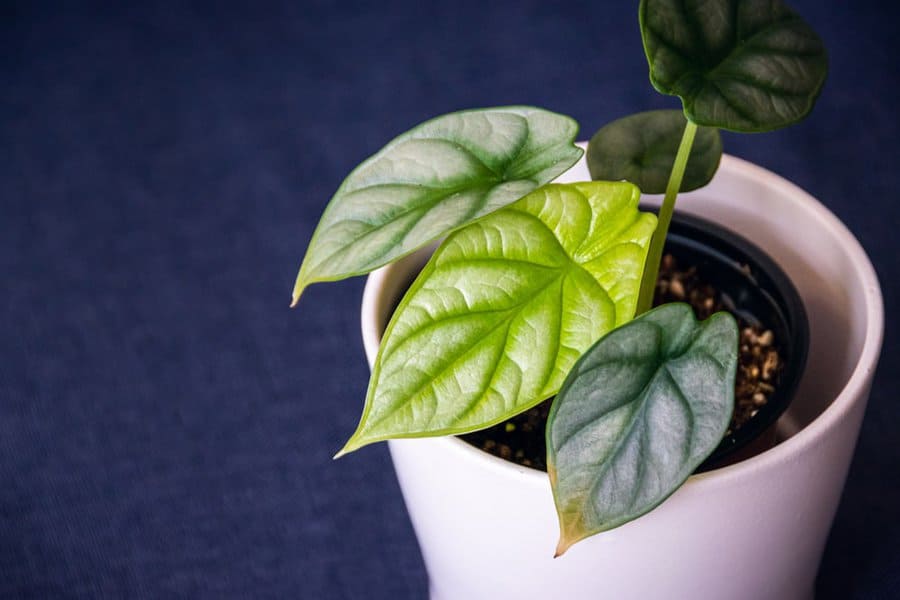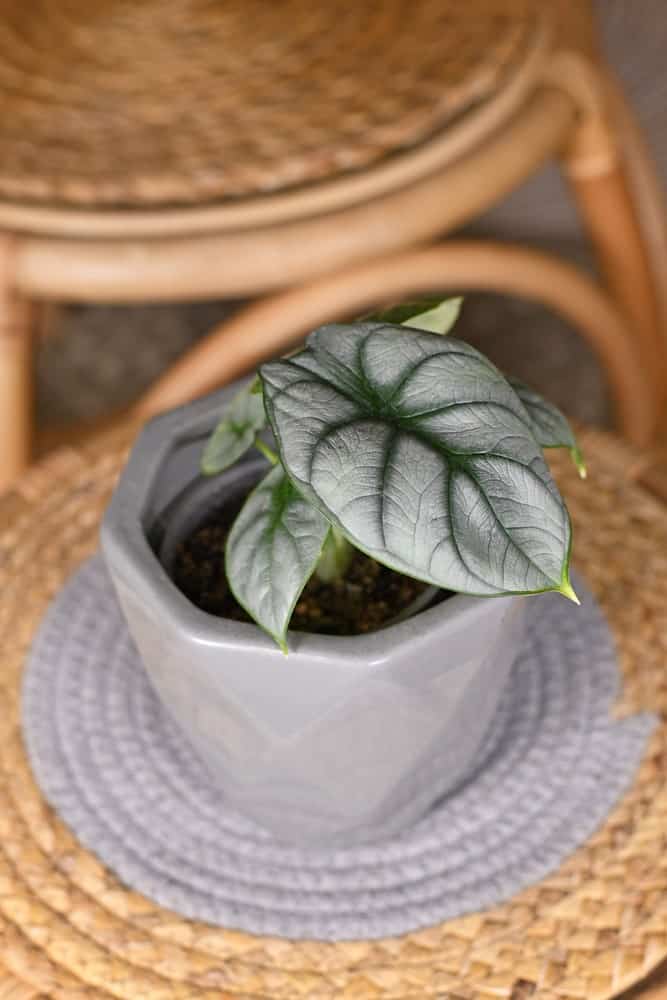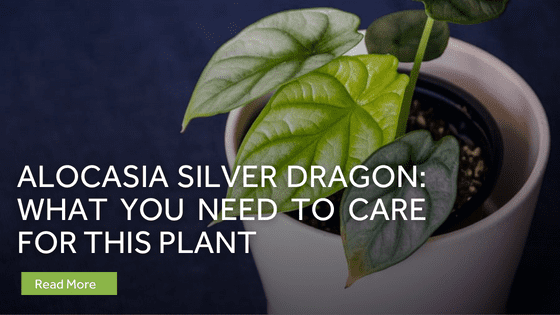The Alocasia silver dragon is one of the most popular and sought-after Alocasia plants due to its stunning silver foliage and venation. The silver dragon is a dwarf Alocasia plant making it perfect for indoor spaces and pots. This plant is low-maintenance and beautiful, making it perfect for beginners and plant experts. Read on to learn more about the silver dragon Alocasia care!
Table of Contents
Alocasia Silver Dragon Overview
The Alocasia silver dragon belongs to the Aroid family or Araceae family. The Alocasia genus is plentiful, with many species renowned for their beautiful foliage. Alocasia silver dragon has the scientific name of Alocasia Baginda and is a highly sought-after cultivar.
The baginda silver dragon originates from southeast Asia and Borneo, making it a compact tropical plant by nature. The Alocasia Baginda earned its nickname of the silver dragon for the silver leaves and dark green veins that resembles dragon scales. Other nicknames include the elephant ear, silver dragon, silver dragon, and dragon scales.
The Alocasia genus is famous for producing beautiful jewel Alocasia plants such as this, but there are many beautiful examples to note. Other silver dragon relatives include Alocasia baginda pink dragon, Alocasia reginula black velvet, and the red secret Alocasia.
| Alocasia baginda pink dragon: | Green foliage stands out amongst the beautiful pink stems of this plant species. |
| Alocasia reginula black velvet: | It is no surprise how this species earned its name with blackish velvety leaves. |
| Red secret Alocasia: | This jewel Alocasia variety shows off a metallic-red sheen within its foliage. |
| Botanical name: | Alocasia baginda |
| Family: | Araceae |
| Genus: | Alocasia |
| Origin: | Southeast Asia, Borneo |
| Sunlight: | Bright indirect light |
| Watering: | Moderate |
| Soil: | Rich, well-draining, aerated |
| Temperature: | 60-80 degrees Fahrenheit |
| Propagation: | Plant division |
| Re-Potting: | Every two to three years |
| Pests and Diseases: | Aphids, spider mites, fungal disease |
| Toxicity: | Toxic to humans and pets |

Alocasia Silver Dragon Features
The Alocasia silver dragon is a dwarf Alocasia meaning it has a smaller height and spread than other Alocasia plants. The height and spread cap are one to two feet when used as an indoor plant.
The stunning foliage leaves on this species are shaped like elongated hearts. These leaves grow three to four inches wide and six inches long. The size and spread of the plant make it great for indoor terracotta pots and terrarium use. This plant foliage resembles dragon scales with silver coloring against dark green leaves.
It is rare to see the silver dragon scale Alocasia flower when grown indoors, but if it does appear, it will be a piston-shaped flower of pale green or white. This plant does not produce fruit and is toxic to humans and animals.
Related Article: Alocasia Regal Shield: Elephant Ear Plant Care Guide
Alocasia Silver Dragon Care Guide
Alocasia silver dragon care is a breeze with this low-maintenance plant. Most tropical plants like the silver dragon prefer environments with bright indirect sunlight that is not too harmful to their foliage. Moderate watering frequency is best to keep the soil evenly moist.
Warm temperatures are best for this species, along with high humidity, to keep the plant happy. Fertilizing is also a great way to supply extra nutrients during the growing season. Read on to get more details!
Ideal Growing Place
The Alocasia silver dragon can successfully grow outdoors as long as the climate conditions are suitable for its preferences. For example, growing your plant outdoors is not the best idea if you live in a colder climate area with low humidity.
Most people keep their silver dragon as an indoor plant because they can easily control the growing conditions that are best for the plant. The growing season for this plant in which the growth rate is highest is during the spring through autumn. Dormancy comes along with winter, and the plant is slow growing.
Water
The watering frequency for this plant can be tricky to get the hang of, but we will explain more. The best thing to remember is to keep the soil evenly moist and not waterlog the soil. Too much water can leave the plant at risk of root rot, and too little water can affect the foliage. During the growing season, plan on watering your plant about two to three times a week since growth is rapid. Once dormancy in winter approaches, reduce watering to about once a week or every ten days.
Sunlight
Adequate sunlight is another key factor in Alocasia silver dragon care. Bright indirect light is best for the Alocasia silver dragon as this is similar to the light it would get in its natural habitat. This plant thrives in natural light from an east-facing window, so place it nearby this area. Too much direct sunlight can scorch the beautiful leaves on this stunning plant.
Temperature
Tropical plants like the Alocasia baginda silver dragon enjoy warm temperatures. Keep your Alocasia plant in a temperature range of 60-80 degrees Fahrenheit to keep it happy. A warm and humid place works best for this plant, and growing indoors is a great way to keep temperatures in the acceptable range. Exposing your plant to too cold of temperatures can stress your plant.
Soil
The best soil mix to grow Alocasia silver dragon scale includes well-draining, rich, aerated, and permeable factors. It is important that the soil remains moist and can drain out any excess water. Alocasia silver dragon prefers slightly acidic soil with a pH from 5.5-7, which can be achieved by adding organic compost or fertilizers. Other additions to the soil that help with the factors above include perlite, peat moss, and coarse sand.
Humidity
Tropical plants like the Alocasia baginda silver dragon prefer high moisture. While other Alocasia plants can be adaptable to lower humidity, this species cannot. A humidity level of at least 80% is needed to support this plant’s health. For those growing their plant in an environment that doesn’t naturally have this level, consider misting, using a humidifier or pebble tray, and wiping down the foliage often.
Fertilizer
Adding fertilizer to your Alocasia silver dragon care is best during the growing season. You can add organic and natural compost or manure to the plant to mimic organic matter from its natural habitat. Other options include a slow-release fertilizer, but no matter the option, make sure you follow instructions carefully and use a half-strength fertilizer so your plant roots are safe.
Pinching/Pruning
Since this compact tropical plant draws attention due to its smaller dwarf size, there is no significant need for pruning. If you notice any dead, dying, or sick leaves, it is best to remove them from the plant carefully so the plant thrives.
Potting and Re-potting
Since this plant grows to a smaller spread and height, it does not often need to be repotted. This plant does not mind being a little rootbound as long as the roots still receive adequate air circulation and water retention. That said, it is still best to repot your Alocasia silver dragon every two to three years to refresh the soil substrate and clean up the root system.
Related Article: All About Alocasia Cuprea: A Care Guide
Growth Zone
So long as the outdoor climate conditions suit this plant, it can grow in various indoor and outdoor spaces. Considering this plant species in your outdoor garden space, the best locations to do this are in the USDA Plant Hardiness Zones 9-11. These zones are localized to the US’s west coast and southern states.
Common Pests, Toxins, Diseases & Other Problems
Common houseplant pests such as aphids and spider mites can affect your Alocasia silver dragon. These pests like to use your plant as a source of food and shelter, which can also harm the foliage and root system. To treat these pests, consider using neem oil or insecticidal soap to get rid of them.
It is best to check your leaves each time you water them to see if you can spot these insects or signs of their presence. Additionally, gently wiping down your leaves with a damp cloth can help prevent them from moving in and give your plant some extra moisture.
However, too much moisture lingering on your plant’s leaves from humidity can also harm the plant. Excess moisture on the leaves can invite harmful fungal diseases, which can spread quickly.
Propagation
It is quite simple to propagate alocasia silver dragon with the common method of using plant division. To propagate alocasia silver dragon with plant division, first, give your plant a nice watering to help loosen the soil where you will be separating rhizome offshoots that will grow into a new plant. Follow these steps to propagate.
- Gently remove your Alocasia plant from the pot and shake off excess soil mix.
- Locate root balls that show where a new plant has formed on the side of the main root area.
- Separate the root balls from the main root area. Each root ball will grow into its own plant once separated and is essentially a clone of the mother plant.
- Place each of the new tropical plants into its own small pot with fresh, moist potting mix to grow on its own.
Alocasia Silver Dragon Mature Timeline
Day 1-30: Place your new Alocasia silver dragon’s pot into a warm and humid area. Ensure your new plant is receiving adequate light to promote new growth.
Day 30-60: During this time, your plant’s shoots will grow as the plant gets stronger and bigger.
Day 60+: Leaves and petioles will begin appearing, and you can care for your beautiful foliage plant as you would normally.

Alocasia Silver Dragon FAQ
How old does Alocasia Silver Dragon Have to Be Before They Bloom?
Alocasia silver dragon rarely blooms when grown indoors or outside of its natural habitat. This plant must reach maturity before blooming either way.
Is Silver Dragon Alocasia a Fast Grower?
The plant itself does not grow to have a tall and widespread, but it does not take this plant longer than a few months to grow and reach maturity.
Where Can I Buy an Alocasia Silver Dragon?
Alocasia silver dragon can be found at larger stores like Walmart and Lowes but is more expensive than other houseplants. Other sites like Etsy and eBay offer this plant where you can purchase online, and they will ship it to you.
Is Alocasia Silver Dragon a Succulent?
Alocasia silver dragon belongs to the Araceae or Aroid family, which is not made up of succulent species.
Is There a Difference Between Alocasia Dragon Scale vs Silver Dragon?
No, the Alocasia Baginda has many nicknames, including dragon scale and silver dragon.
What Kind of Pot Is Suitable for an Alocasia Silver Dragon Plant?
Terracotta pots, terrariums, and regular houseplant pots are all suitable for this species. However, ceramic pots like terracotta pots are favored because they help aerate the soil and absorb excess moisture.
Where Is the Alocasia Silver Dragon From?
Alocasia silver dragon originates from Southeast Asia and Borneo and is one of many tropical plants in the Araceae family.
Why Is My Alocasia Dropping Leaves?
Many factors can come into play when your Alocasia plant starts dropping leaves. The main possibilities to rule out include over or underwatering, pests, inadequate lighting, and insufficient soil nutrients.
Why Is My Alocasia Silver Dragon Yellow?
There are two main reasons why your Alocasia silver dragon is turning yellow. This can result from giving your plants too much water or the soil being too dense for the plant.
Is It a Good Idea to Add Lime to the Soil to Grow Alocasia Silver Dragon?
Adding lime to your Alocasia silver dragon soil can be beneficial. This plant has been known to thrive in calcium-rich limestone regions of the world.
Why Is My Alocasia Silver Dragon Drooping?
Drooping leaves of your Alocasia silver dragon are usually a result of improper watering frequency and amount. Too much or too little water can make your foliage unhappy.
How Do You Save a Dying Alocasia Dragon Scale?
The best way to care for your Alocasia silver dragon when it shows signs of stress is to follow each care guide recommendation and follow it. Start by ruling out watering frequency, humidity, lighting, and temperature. If those factors are in order, look to pests, soil mixture, and fertilizing and see if you can improve in these areas.
Is Alocasia Dragon Scale Expensive?
Alocasia silver dragon is a rarer plant than most houseplants. Due to this, prices are higher for this species than for others.
Is Alocasia Silver Dragon Rare?
Yes, the Alocasia silver dragon is a rare type of Alocasia and one of the most sought-after.
Is Alocasia Silver Dragon Toxic for Humans and Pets?
The Alocasia silver dragon should be kept out of reach for children and pets because it is toxic with calcium oxalate crystals. This compound can cause severe irritation.
The Bottom Line
If you want to add a rare and beautiful Alocasia to your collection, look no further than the Alocasia silver dragon. This species of Alocasia catches the eye with its striking silver and dark green leaves contrasting. After learning more about its care, you can now help this plant thrive in your space!
Last Updated on September 12, 2022 by Gustaf Johansson




